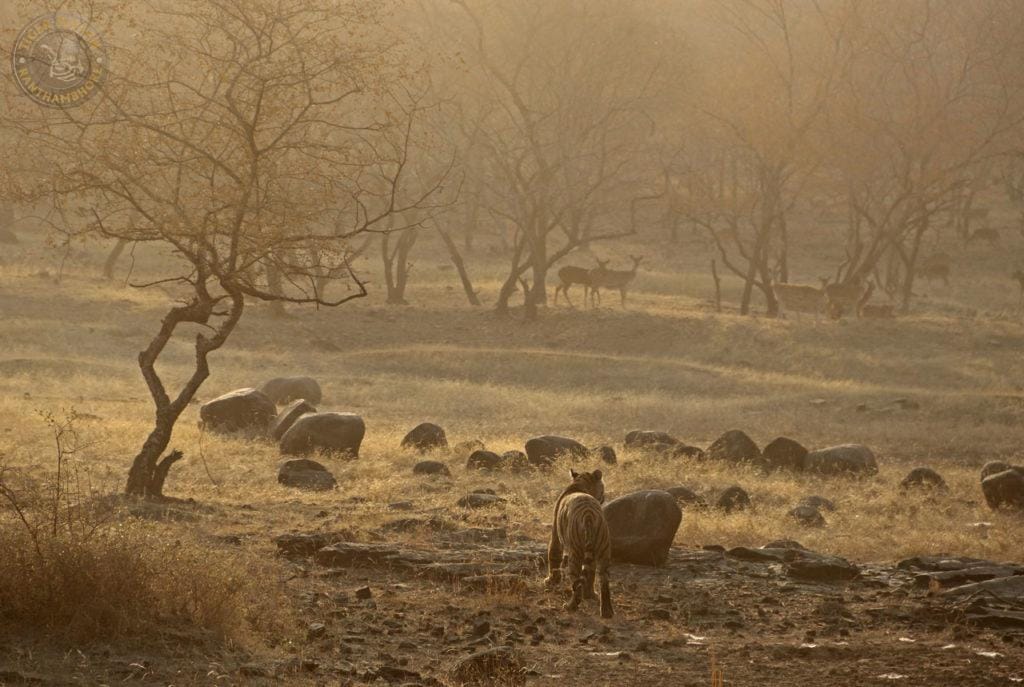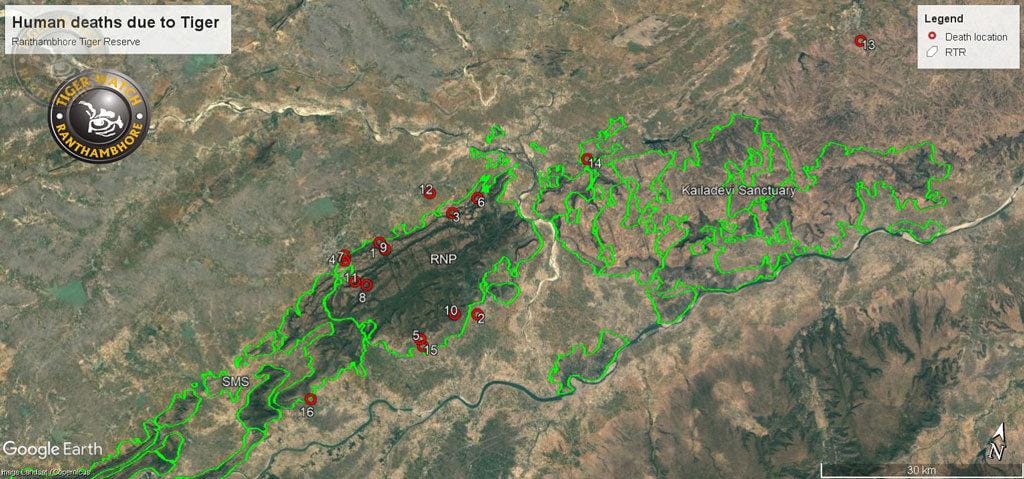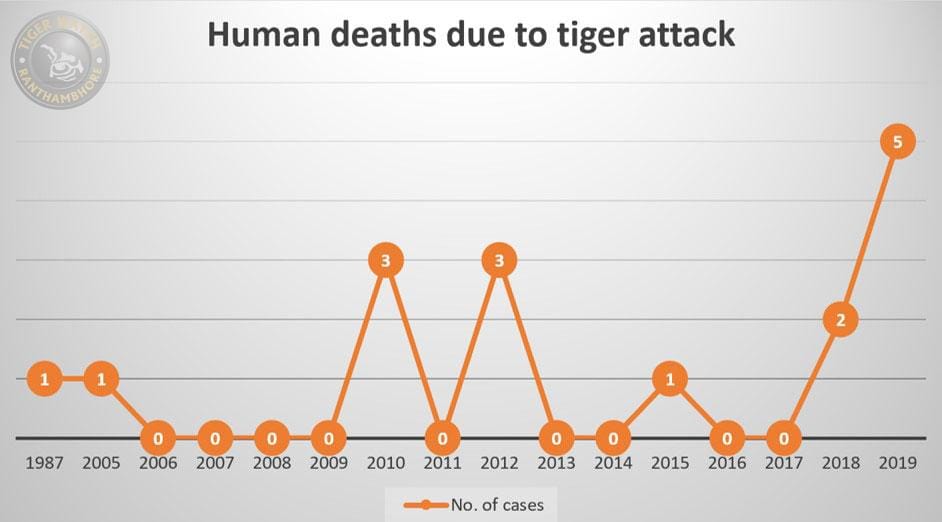
Due to their sudden rise, there is much discussion and debate around the recent tiger attacks in Ranthambhore. Tiger Watch has analysed all the facts surrounding tiger caused human fatalities in and around the Tiger Reserve. The following are our findings which are limited to attacks in the last decade, but reveal specific identifiable trends ever since the beginning of consistent tiger attacks in 2010.

- Since the formation of Ranthambhore Tiger Reserve in 1973, a total of 16 people have been killed by the tigers.
- Among the total of 16 attacks, only 5 attacks occurred outside the park. Out of the total of 5 attacks outside, 3 were on the periphery of the park (very close to the reserve border) one was 14 km away and the other was 2.5 km away from the tiger reserve.
- After 14 years of the Tiger Reserve’s formation, the first attack happened in 1987, when a boy went off the paved road where he encountered a tiger and was killed immediately. This was on the main Ganesh road, near Ada Balaji.
- 18 years later, the second attack happened (in 2005), when a male tiger attacked a 60 years old farmer in the village of Mai in Khandar area. It occurred in the night when he was watering his wheat crop. The man had wrapped a black blanket around himself.
- Consistent human-tiger conflict started from the year 2010 and a total of 14 human beings have been killed until now.
- In the year 2010, a total of 3 human beings were killed by tigers. The year 2011, was completely peaceful but in the years 2012, 3 human beings were killed. In the years between 2008 to 2013 around 7 tigers have been translocated to Sariska Tiger Reserve, 2 of them were males and 5 of them were females. The translocation of more females may have created an imbalance, causing male tigers to spend more time wandering the peripheral areas looking for females putting them into contact with humans.
- The years 2013, 2014 were peaceful but in 2015, 1 human being was killed. The year 2016 and 2017 were peaceful.
- In the years between 2012 to 2015, many critical villages like Padra, Kathuli, Mordungari and Bhid were relocated outside the park by the government and the result was quickly apparent, conflict between tigers and human beings drastically reduced. In a period of 5 years (2013 to 2017) only 1 man was killed by a tiger.
- In the year 2018- there was a total of 2 victims and in 2019 a total of 5 victims were killed. Despite the relocations ( there have been no more since), the newly available space was quickly occupied by the rapidly growing population of the tigers.
- Interestingly out of a total of 16 attacks, only 3 victims were women and 13 were men.
- Most of the identities of the tigers responsible were established by the authority. All the victims were attacked by male tigers except in 2 attacks.
- A total of 11 tigers were involved in 16 human deaths.
- Only 2 tigers killed multiple human beings. Tiger T-24 killed 4 human beings and tiger T-104 killed 3 human beings.
- The victims of the tigers were attacked whilst in the middle of a myriad of activities – 5 were cutting wood in prohibited areas, 2 were grazing livestock inside the park, 2 were cutting grass in the park, 2 were tending to their fields, 1 was defecating openly and 1 was urinating off the road in the forest, 2 forest guards were on foot patrol, and 1 was unknown.
- A total of 7 fatal attacks occurred in winter (Dec to March), a total of 6 attacks occurred in the monsoon (July to October) and only 1 attack occurred in the summer (April to June). There were no attacks in the months of April, June and November.

Conclusion:
Question 1: So why the sudden rise of tiger attacks in Ranthambhore?
Question 2: Why were there attacks in some years and other years peaceful?
In the last decade (since 2010), a total of 14 human beings have been killed because of the following reasons…
A. INCREASE IN TIGER POPULATION: Pro-active anti-poaching and modern monitoring techniques resulted in the tiger population increasing exponentially in Ranthambhore. In 2006, there were only 18 tigers and now there are 62 + tigers in the landscape, which means it has increased 3-4 times.
B. PROCESS OF NATURAL ELIMINATION STOPPED: Young and old male tigers are the main culprits. There is a natural system to regulate the population of male tigers in any tiger ecosystem- by male on male combat. In the last 2 years the Forest Department intervened to save old male tigers or sub adult male tigers after they were injured in natural male on male combat at least 10-15 times. (T109, T28, T06, T 23, T 91, T 34, T 104 multiple times, T109 again,). These tigers were not only treated but were also unnaturally sustained with prey substitutes. When we don’t make more habitat available for tigers and yet not allow the tiger population to regulate itself naturally, the natural balance is bound to be destroyed.
Points to ponder:
These points need more discussion to get the real picture:
- There is a debate on the notion that pressure from safari tourism forces tigers to move towards the park periphery where they are harming human beings. Their logic is that all man killing tigers were born and brought up in the tourism area and finally moved to the edges due to heavy human traffic inside the park. This is a flawed theory because if the traffic was so high then why were they born in the area and successfully raised there? Why is the density of tigers so high in the tourism area, presently 31 tigers (50%) are roaming in the 16 % of the reserve which constitutes the tourism area?
- Excessive human interaction with animals like- Tiger T-24 which were treated and darted multiple times and similarly tiger T-104. They are the only tigers who killed multiple human beings (4 and 3 respectively). Animals retain ‘bad’ experiences and then act accordingly. Medical interventions are very stressful for wild animals- heavy tranquillising drugs , the tranquillising process is also hectic, the pervasive smell of humans is an unusual experience and can make a tiger a problem animal. Similarly, this point also need more discussion to establish or reject this.
- Bad management decisions and not making the correct decisions on time, like the release of known man -killers like tiger T-104 after their capture, have also contributed to the increased human fatalities. Tiger T-104 was captured and released twice after killing and feeding on 2 people in 2019. Even after his capture following his 2nd killing in August, when his predilection for man-eating was very apparent, he was released and he promptly killed a 3rd victim on September 12th, 2019. The department cited the NTCA as the reason for releasing him twice. Even in the case of T-24, the department did not agree to remove him despite his killing and feeding on 3 victims citing the outgoing State Forest Minister, resulting in the forest guard Rampal Mali paying for this with own his life as the 4th victim in before he was finally removed in 2015.
- Management instability also has a role to play as it has hampered the ability to monitor the evolving dynamics on the ground and to make appropriate decisions during times of crisis such as this. This can be attributed to decision making at the higher echelons of the Department. For example, at the range officer level in Ranthambhore, the officers feel that they can be transferred at any time with little justification. The post of the range of Falodi has seen multiple transfers in a relatively short period of time. The same holds true for other ranges. Even at the forest guard level in the same ranges, good guards have been transferred with little justification.
By Dharmendra Khandal, Ishan Dhar, Sachin Rai, Divya Khandal and Meenu Dhakad


Trackbacks/Pingbacks